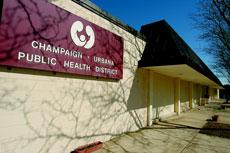CU raises STI awareness

The Champaign-Urbana Public Health District building, located at 710 N. Neil St. in Champaign, holds STI walk-in clinics at select times during the week. Austin Happel
April 18, 2006
The American Social Health Association has declared April as National Sexually Transmitted Diseases Awareness Month. As a part of the awareness month, the Champaign-Urbana Public Health District is offering citizens and health care providers resources to assist in sexually transmitted infection education, screening, diagnosis and treatment issues.
The health district also offers three weekly STI clinics for all Champaign County residents. Anyone over the age of 12 can attend the clinics without parental consent.
According to the health district’s Web site, STIs are one of Champaign County’s most persistent and preventable health problems.
“Champaign County is one of the highest counties in the state of Illinois in STD rates,” said Julie Pryde, director of Infectious Disease Prevention and Management for the health district. “And the high rate of STDs is not due to a lack of access – people can easily obtain free condoms from public health centers.”
Certain types of STIs are more prevalent than others.
Get The Daily Illini in your inbox!
“Syphilis has become a problem in the last few years,” Pryde said. “We have had two outbreak alerts here in the past several years.”
Sonya Kuykendall, public health nurse for the health district said there is currently a syphilis outbreak in the county.
“From an epidemiological standpoint, (Champaign County is) following the trend of larger cities,” Kuykendall said. “It is not only U of I that drives the high STD rates, though it contributes to it. Because Champaign is a college town, people are mobile, transient . they come and go, and with (STDs).”
Unfortunately, public awareness of STIs remains critically low throughout the country while STIs are occurring at epidemic levels, particularly among 15-29 year olds, according to the health district’s Web site.
According to the American Social Health Association Web site, each year 1 in 4 sexually active teens gets an STI; 1 in 2 sexually active persons will contract an STI by age 25. Half of all STIs and HIV infections occur among people 25 and younger. In 2005, 72 percent of all chlamydia cases occurred in adolescents and young adults between 15-24 years of age.
The health district and the Champaign County Public Health Department are part of a national effort to reduce STI incidence and prevalence. They are trying to prevent the spread of STIs through education.
“People just need to use prevention. If they’re not going to be abstinent, use condoms or latex barriers,” Pryde said. “And if somebody has a lesion, they should not touch that lesion. They may have the best intentions, but you start drinking and your inhibitions fly to the wind.”
According to the health district Web site, nurses in the infectious diseases division perform outreach and testing at local jails, juvenile detention centers, schools and homeless shelters.
“We do targeted outreach, such as putting up posters and Internet outreach,” Kuykendall said.
According to the health district Web site, education and testing are crucial, as many STIs may show few, if any, outward symptoms. The only way to know for sure is to get tested.






